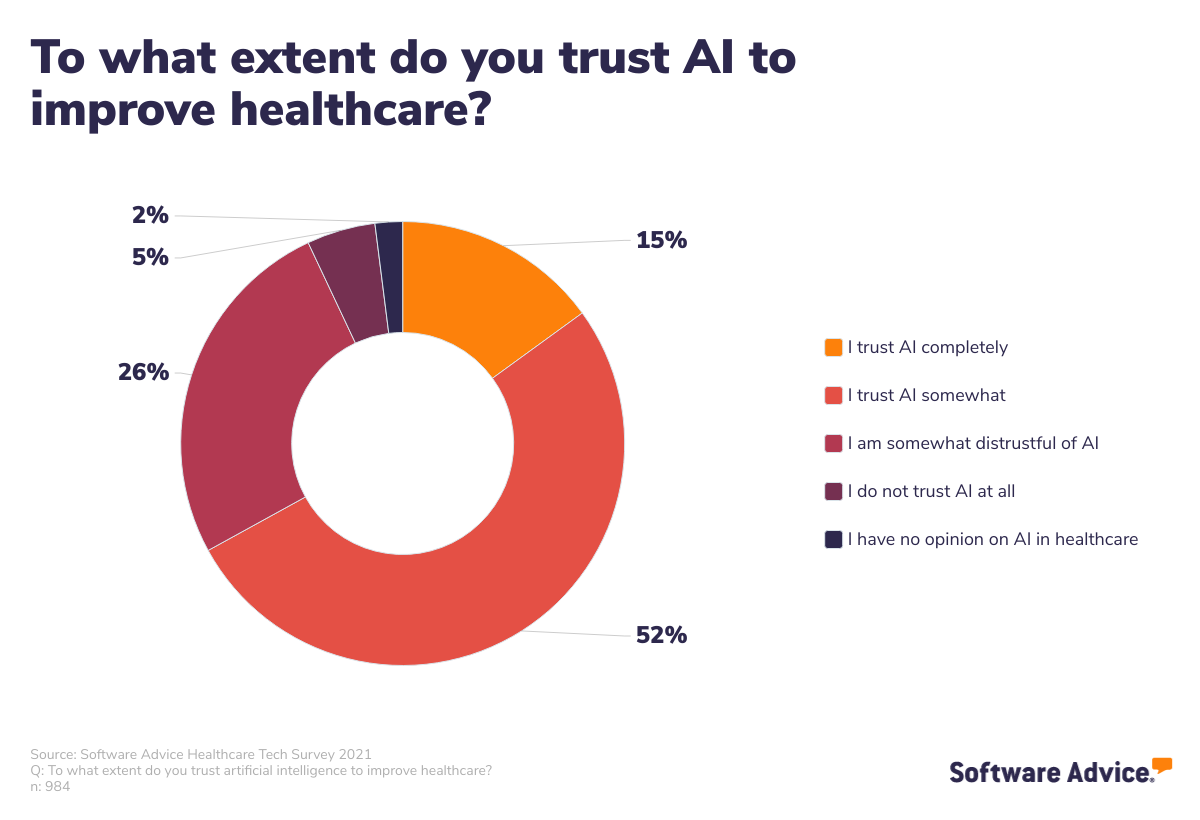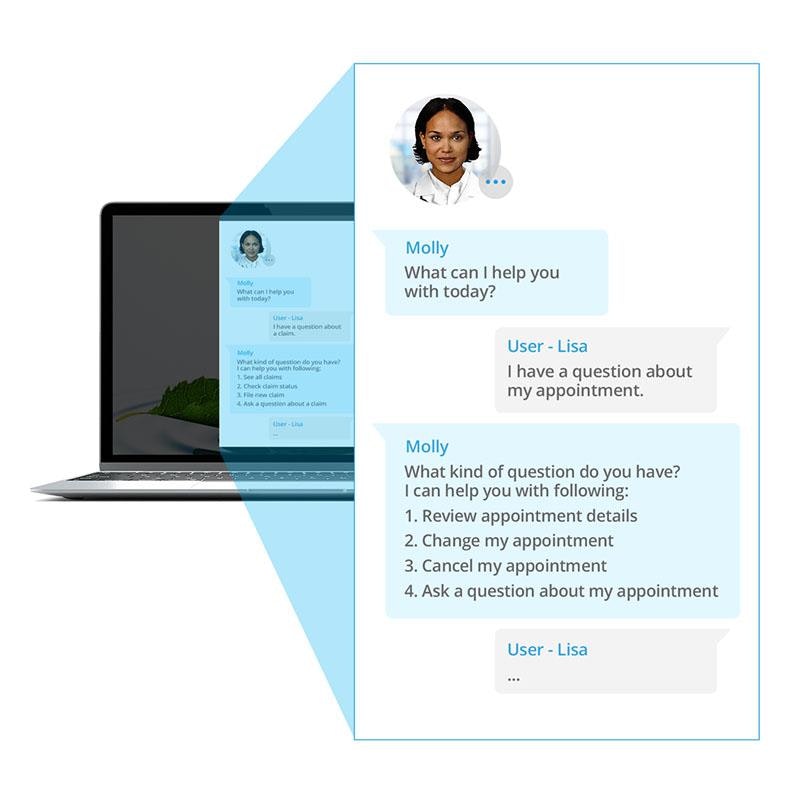3 Benefits of Artificial Intelligence in Healthcare You Should Know About Right Now
The sheer amount of data needed to make consistently accurate medical diagnoses is staggering. That’s why many healthcare organizations are adopting artificial intelligence to improve decision-making and make nearly every aspect of running a practice easier and more efficient.
According to Gartner, “The AI/smart machine era will be the most disruptive in the history of IT. … Eventually, these advances will redefine what it means to be a physician and a patient.” (Full content available to Gartner clients.)
Whether it’s using machine learning to help with diagnoses or automation tools to communicate with patients, artificial intelligence can streamline medical processes so you have more time to focus on what’s important: helping your patients.
If you have never considered using artificial intelligence for your practice, don’t trust artificial intelligence, or think your patients might not trust artificial intelligence, it’s time to reconsider. A recent Software Advice survey* demonstrates that most patients trust the application of artificial intelligence in healthcare.

In this article, we discuss three artificial intelligence technologies you can bring to your practice right now to improve experiences across the board—for your patients as well as staff.
1. Improve patient experience and retention with AI-powered chatbots
AI-powered chatbots are perhaps the most used AI technology in the healthcare industry right now because they are easy to implement, improve the patient experience, and help medical professionals interact with and treat patients without the massive time sink that traditional customer service methods take.
This AI application uses natural language processing (NLP), sentiment analysis, deep learning, machine learning, and concept extraction algorithms to provide instant answers to patients’ statements or questions on topics such as bill payments, appointment scheduling, and medication refills.

OneRemission’s AI-powered chatbot used from a mobile device (Source)
How intelligent chatbots benefit patient care
With a quick chat, an AI-powered chatbot identifies your patients’ needs by asking questions about the symptoms and problems they’re experiencing. It then assesses and understands their issues—based on the answers received—and guides them to the next steps.
Chatbots help improve the patient experience—they’re user-friendly, interactive, and available 24/7. After all, we’ve all been awake at 2 a.m. wondering if that thing on our leg might be serious or not.
Also, patients are likely to feel more comfortable speaking to a chatbot, rather than to a person, about sensitive issues. They might disclose more details, which helps provide a better diagnosis when you see them in person. And if the issue is serious, chatbots can lead patients all the way to your practice by assisting them with booking appointments.
How intelligent chatbots benefit practices
Overall, improving the patient experience leads to higher patient retention and more referrals, helping your healthcare organization thrive. It also saves time, which is always in short supply around a practice.
2. Support your patients and staff with virtual assistants
A virtual assistant is an AI system created to engage patients. It uses augmented reality, cognitive computing, machine learning, deep learning, and speech recognition to provide a personalized experience in which patients can ask questions and learn how to better manage their health.
Unlike an AI-powered chatbot, a virtual assistant is meant to assist patients every step of their treatment by providing consistent support instead of one-off interactions.
Virtual assistants also support administrative staff by streamlining clinical workflows within a medical practice. They help exchange patients’ health history, insurance, and demographics data between different departments to ensure everyone is on the same page and nothing gets lost in the shuffle.

Sensely’s AI-powered virtual assistant, Molly, helping a user (Source)
How virtual assistants benefit patient care
Virtual assistants help your patients at every step of the treatment process, letting them access their digital health records whenever required. Whether it’s scheduling an appointment, navigating the patient portal, or collecting patient data pre-visit, an AI-powered virtual assistant ensures the patient experience is as seamless as possible, which improves patient engagement and communication for your practice.
How virtual assistants benefit practices
The primary benefit your practice gets from a virtual assistant is more time. This technology automates most administrative tasks such as scheduling appointments or post-visit follow-ups and collecting payments. As a result, doctors have more time to attend to their patients instead of completing manual paperwork.
Additionally, AI-powered virtual assistants support practitioners by recommending diagnostic and prescription options and messaging patients about routine queries.
3. Optimize performance and operational efficiency with intelligent decision support systems (IDSS)
Traditional clinical decision support systems (CDSS) warn healthcare professionals of contraindications and recommend alternative treatment plans using clinical guidance and rules from medical science. They work but require a lot of personal touch from medical professionals.
An IDSS, on the other hand, uses AI to make these recommendations. It uses intelligent behavior, such as machine learning and reasoning, and the data collected from patients to help practitioners diagnose diseases accurately.
And because it works on machine learning, it gets better and better with use. Unlike a traditional CDSS model, healthcare professionals take a more supervisory role with an IDSS.
How IDSS benefits patient care
An IDSS helps ensure better patient safety for a variety of reasons. Let’s say a physician fails to spot an incorrect medication dosage for any reason—after all, mistakes happen. An IDSS can easily spot this mistake by comparing the current dosage with previous dosages from past prescriptions and flag it to the physician before the patient gets a refill. In all, the main function of an IDSS is to warn you when the rules and patterns it’s set up to detect aren’t met.
How IDSS benefits practices
Timesaving is the key benefit of using an IDSS for your medical practice. Because the technology runs mostly on its own without much human intervention, it allows physicians to play a supervisory role. They won’t have to make the hands-on decisions that they would otherwise be entirely in charge of making.
Bonus technologies your practice should be aware of
Diagnostic medical imaging interpretation: Artificial intelligence is helping make faster and more accurate medical image readings (X-rays, MRIs, and CT scans) by using deep learning from data and categorization technology. We don’t need to tell you how big of a boon this will be for patients and practices alike as the technology grows.
Precision health: Precision health focuses on preventative care based on patient data collected from wearable devices, advanced electronic health systems, genetic information, lifestyle choices, physical environments, and biometric health systems, among others. It uses AI to identify potential risks while suggesting preventative interventions when it detects problems.
Artificial intelligence is the future of healthcare, so adapt and adopt
Luckily for you, artificial intelligence has been used by large healthcare firms for years now. So, it’s been evolving by learning the medical data of hundreds of thousands of patients from around the world.
As a small practice, you get to reap the benefit of these large healthcare firms because not only is the technology improving but patients are also growing more used to it. In fact, they might even come to expect it in the future.
If you have an EHR you’re comfortable with, consider integrating the discussed artificial intelligence technologies with your current software stack to boost productivity and efficiency while reaping the benefits these AI tools grant your practice.
However, if you’re just getting started with your software search, you might want to stick with a more basic EHR until you and your team are comfortable using the technology to its full potential, then add on functionality as you need.
In either case, if you’re looking for software, we’ll help you find the right tool for your needs and budget in 15 min or less, for free. Schedule a call or click here to chat with a software advisor now.
Survey methodology
To collect the data presented in this report, we surveyed 1,296 patients within the U.S. in May 2021 to learn how exactly they feel about certain healthcare technologies in order to help healthcare providers better understand which software and tools to prioritize for their patients. We used screening questions to narrow the respondents down to 1,001 with the relevant and timely experience needed to provide accurate answers to these survey questions.
Note: The applications selected in this article are examples to show a feature in context and are not intended as endorsements or recommendations. They have been obtained from sources believed to be reliable at the time of publication.